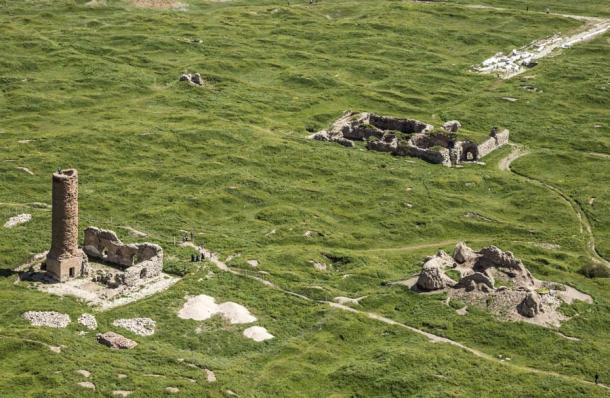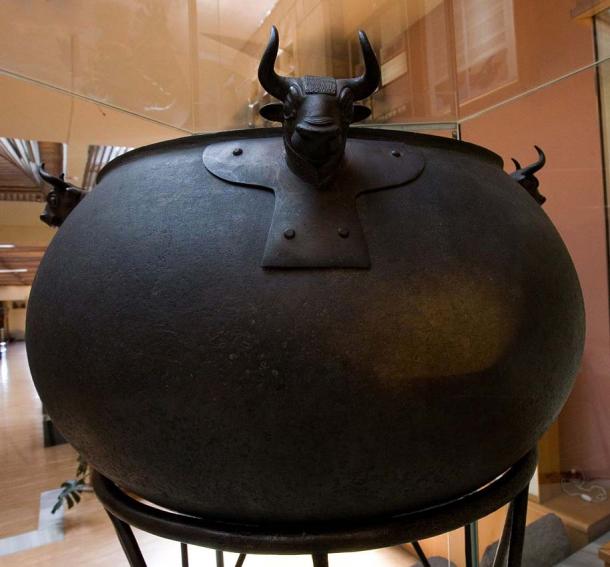A team of archaeologists from Van Yüzüncü Yıl University recently unearthed the remains of a 2,800-year-old castle in eastern Turkey, which was first reported by Turkey’s Anadolu Agency , one of the country’s top media outlets. The team discovered the buried castle at an altitude of 8,200 feet (2,500 meters), on a rugged mountain peak in the Gürpinar district of eastern Van province. The design, material characteristics, and location of the castle and its artifacts helped the archaeologists reach an immediate realization. They recognized the ancient building as a fortress constructed during the Urartian era, when the area around the modern province of Van was a major stronghold of the prosperous and powerful Kingdom of Urartu, which is also known as the Kingdom of Van.

The spectacular ancient castle of Van in Turkey, known also as Tushba Castle or the Fortress of Van, was built by the Urartians. It is known as the largest mountaintop fortress anywhere in the world. ( MehmetOZB / Adobe Stock)
The Urartian Civilization And Their Mountaintop Fortresses
The mighty Urartian civilization ruled a region that included what is now eastern Turkey and the Republic of Armenia for nearly three centuries, from approximately 860 BC to 590 BC. They built many mountaintop castles and fortifications during this time, including the famous Fortress of Van , which is located 28 miles (45 kilometers) north of the city of Gürpinar. The Van castle is the largest ancient mountaintop fortress anywhere in the world.
Since excavations are still in the beginning stages, it is too soon to determine the exact measurements of the Gürpinar district Urartian castle. Among their discoveries so far, the archaeologists have found some pieces of ceramic pottery and intact sections of the castle’s sturdy walls, which were built from limestone and sandstone .
Their most notable discovery was an undamaged cistern or water storage tank , which they dug out very near the top of the peak. The cistern was 21.3 feet (6.5 meters) deep, 8.2 feet (2.5 meters) wide, and 21.3 feet (6.5 meters) long. When it was full, the cistern would have held up to 27,700 gallons or 105,000 liters of water.
Even though it was constructed 2,800 years ago, it seems the castle remained in use long after that.
“Although it is believed to be dated back to the Urartian era like the Van Castle, we see that it was mostly used in the Middle Ages,” Rafet Çavuşoğlu, a Van Yüzüncü Yıl University archaeologist and excavation team leader, told the Anadolu Agency news site .
It is a testament to the construction skills and planning abilities of the Urartians that the castle was apparently still suitable for occupation 2,000 years after it was first erected.

The Urartian ruins around Turkey’s Lake Van. ( berna_rikur / Adobe Stock)
The Story of the Legendary Urartian Civilization
The Urartians were blessed to live in an area that provided for all their needs and guaranteed their prosperity.
Living in a rocky and mountainous region, they built their farms and settlements on a fertile high plateau, which was irrigated naturally by river water. Here they grew a broad variety of vegetables and fruits, and took their cattle, horses, and sheep to graze on nearby green mountain pastures. The Urartians were pioneers in the art of winemaking and may have been the first to introduce it to the region. Rich deposits of precious metals like gold, silver, copper, lead, and iron could be found close by, and the Urartians mined these substances for their own use and for their value in exchange.
The lands of the Kingdom of Urartu were in close proximity to ancient trade routes that ran from the Mediterranean region going east into Anatolia and Asia. With attractive products of all types to trade, the Urartians became even wealthier and more prosperous as time passed.
But throughout the 270 years the Kingdom of Urartu endured, there were always storm clouds forming just over the horizon. While the surrounding mountains gave them some protection, there were always external threats to worry about. The kingdom’s great wealth attracted invaders and would-be conquerors, forcing the Urartians to always be ready for battle.
Just to the southwest, the Neo-Assyrian empire posed a constant threat to the safety and security of the Urartians. In fact, the Urartian kingdom was originally founded by smaller states that feared the Assyrians and decided to pool their political and military resources to defend against this dangerous adversary.
The Urartians were involved in many conflicts throughout their kingdom’s existence, as they struggled to protect their borders. Therefore, they had to stay on alert at all times and make security a top priority.
This was one reason why they built so many castles and fortifications on the tops of mountain peaks. From these high altitudes, they could survey the surrounding countryside and spot invading forces while they were still far away. Once the invaders arrived, they would find it extremely difficult to make it up the mountains without being destroyed by the well-prepared Urartian forces who had a significant strategic advantage.
These mountaintop locations could also be kept safe if civil war were to break out. This may have been a concern to the kingdom’s leaders since armed revolts were fairly common in military-oriented societies.
Unfortunately, their perpetual struggle for survival ultimately doomed the Urartian civilization. Their cities were attacked and destroyed by unknown conquerors around 590 BC.
Their capacity for self-defense may have been weakened by more than 250 years of warfare, which may have drained their economy and caused their population numbers to drop. Or perhaps they’d spread themselves too thin by becoming involved in too many conflicts at the same time, leaving them vulnerable to attack from a particularly strong enemy.
Whatever the reasons for its demise, the Kingdom of Urartu left behind many physical signs of its greatness, mainly in the form of its formidable mountaintop fortresses.

A Urartian cauldron from the Museum of Anatolian Civilizations, Ankara, Turkey. (EvgenyGenkin / CC BY-SA 3.0 )
Further Excavations At the Gürpinar Castle Will Tell Us More
As excavations continue at the newly discovered castle in eastern Van, archaeologists will likely discover new and possibly surprising details about the culture that built it. They may also learn much more about the people who lived in the region afterward, since it appears the castle was occupied for more than 2,000 years after it was first constructed.
Local officials hope this latest discovery will help attract visitors interested in learning more about the region’s fascinating history.
“In cooperation with Van Yüzüncü Yıl University, we made an important discovery here,” stated Hayrullah Tanış, the district mayor of Gürpınar. “We found a new castle witnessing the Urartian period and the Middle Ages. This discovery excites us in terms of tourism and culture.”
Despite disappearing nearly 2,600 years ago, the prosperous Kingdom of Urartu is still remembered because of the spectacular ruins and artifacts they left behind.
Top image: The outlines of the 2,800-year-old Urartian castle, the most recent discovery of its kind, found in eastern Turkey recently. Source: Anadolu Agency
By Nathan Falde
Related posts:
Views: 0
 RSS Feed
RSS Feed















 June 23rd, 2021
June 23rd, 2021  Awake Goy
Awake Goy  Posted in
Posted in  Tags:
Tags: 
















